- President Obama
- Attorney General Eric Holder
- Michael Brown
- Missouri
- Ferguson
- Darren Wilson
- Cleo Wright
- Sikeston
- Charleston
- Grace Sturgeon
- Ardella Wright
- University Press of Kentucky
- St. Louis
- Terry Teachout
- New York Times
- Marshall Currin
- Southwest Missouri State University
- Emory University
- Roger Corman
- William Shatner
- The Intruder
- Helen Currin
- Carol Anderson
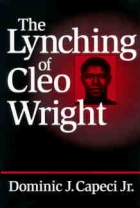
The Lynching of Cleo Wright, by Dominic J. Capeci, Jr. (The University Press of Kentucky, Lexington, Kentucky, 1998, 274 pages).
Book Review by Dennis Moore
August 25, 2014 (San Diego's East County) - Terry Teachout, a New York Times critic, playwright, and inveterate blogger, and I have something in common. He and I were both born in the “bootheel” of Missouri, he in Sikeston and I in Charleston – in the area of one of the most tragic and heinous lynchings in the annals of America; the lynching of Cleo Wright. We both, also have weighed in on Dominic J. Capeci’s book; The Lynching of Cleo Wright, which has been described as “a creatively conceptualized anatomy of a lynching, and “Capeci places the lynching of Cleo Wright within the context of the city of Sikeston, the state of Missouri, and the nation.” This book should also be viewed in context with the ongoing furor and debate of Ferguson, Missouri and the shooting death of unarmed black teenager Michael Brown by a white policeman.
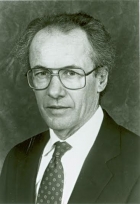 Having been born in Charleston, Missouri, just 14 miles from where this infamous Cleo Wright lynching occurred, I have actually spoken to someone identified in Capeci’s book, and grew up around him. This person, Marshall Currin, was recognized as one of the leading black civil rights leaders in Charleston, and the state of Missouri. As a matter of fact, after the lynching of Cleo Wright and the ensuing tension and uproar throughout the state and country, the Governor of the State of Missouri invited Currin and other black ministers and leaders from throughout the state to the State Capital for a meeting in an attempt to quell the unrest. I had no idea at the time that this quiet and unassuming man that was serving me hamburgers and root beer sodas at their family restaurant in Charleston, had played such a prominent role in history and civil rights. The author actually indicates in the bibliography of the book that he interviewed the wife of Marshall Currin, Helen Currin, in Charleston on May 19, 1988. I remember her well, as we used to refer to her as “Ms. Helen.” I would have loved to have been a fly on the wall when Capeci was interviewing Helen Currin!
Having been born in Charleston, Missouri, just 14 miles from where this infamous Cleo Wright lynching occurred, I have actually spoken to someone identified in Capeci’s book, and grew up around him. This person, Marshall Currin, was recognized as one of the leading black civil rights leaders in Charleston, and the state of Missouri. As a matter of fact, after the lynching of Cleo Wright and the ensuing tension and uproar throughout the state and country, the Governor of the State of Missouri invited Currin and other black ministers and leaders from throughout the state to the State Capital for a meeting in an attempt to quell the unrest. I had no idea at the time that this quiet and unassuming man that was serving me hamburgers and root beer sodas at their family restaurant in Charleston, had played such a prominent role in history and civil rights. The author actually indicates in the bibliography of the book that he interviewed the wife of Marshall Currin, Helen Currin, in Charleston on May 19, 1988. I remember her well, as we used to refer to her as “Ms. Helen.” I would have loved to have been a fly on the wall when Capeci was interviewing Helen Currin!
Dominic J. Capeci, Jr., professor of history at Southwest Missouri State University, and the editor of Detroit and the ‘Good War,’ concludes that the Sikeston event contributed more to the subsequent history of civil rights and race relations than any other in the state of Missouri, as stated by Richard S. Kirkendall. Now, and some 70 years later, the recent and ongoing racial strife in Ferguson, Missouri is like Déjà vu. Ironically, the killings of Cleo Wright in 1942 and Michael Brown in 2014 in Missouri, started the same way, with both of these black males being stopped by police in a car as they were walking down the street.
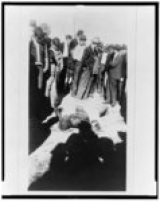 On January 25, 1942, black oil mill worker Cleo Wright allegedly assaulted a white woman in her home in Sikeston, Missouri, and nearly killed the first police officer who tried to arrest him. An angry mob then hauled Wright out of jail and dragged him through the streets of Sikeston before burning him alive. This, according to Capeci. Wright was actually tied to the bumper of a car and dragged through the streets of Sikeston, with eight bullet holes in him, and then deposited in front of a black church while they were having service, and then doused with five gallons of gasoline and burned alive. I can’t begin to imagine what horror and pain that scene must have been like for the parishioners worshipping God, or the agony and pain that Wright felt and endured! The author writes of a mass exodus of blacks from Sikeston, after viewing this brutal scene, stating; “Blacks who happened upon Wright’s dragging and burning never forgot, and youthful witnesses experienced nightmares for some time afterward.”
On January 25, 1942, black oil mill worker Cleo Wright allegedly assaulted a white woman in her home in Sikeston, Missouri, and nearly killed the first police officer who tried to arrest him. An angry mob then hauled Wright out of jail and dragged him through the streets of Sikeston before burning him alive. This, according to Capeci. Wright was actually tied to the bumper of a car and dragged through the streets of Sikeston, with eight bullet holes in him, and then deposited in front of a black church while they were having service, and then doused with five gallons of gasoline and burned alive. I can’t begin to imagine what horror and pain that scene must have been like for the parishioners worshipping God, or the agony and pain that Wright felt and endured! The author writes of a mass exodus of blacks from Sikeston, after viewing this brutal scene, stating; “Blacks who happened upon Wright’s dragging and burning never forgot, and youthful witnesses experienced nightmares for some time afterward.”
Capeci gives a graphic and horrific depiction of the actual assault of Grace Sturgeon in his book The Lynching of Cleo Wright, as he states: “The bloodshed began early Sunday morning, January 25, at 847 East Kathleen Avenue in the so-called shoe factory district of southeast Sikeston. There, Grace Sturgeon resided with her eight-year-old son Jimmy and her sister-in-law Lavern Sturgeon, sharing the house while their husbands – brothers James and John – served in the armed forces. Grace Sturgeon awoke first, first hearing noise in the kitchen around 1:00 A.M., where someone attempted to open the back door by cutting its glass and reaching in to undo its lock. Thirty minutes later she heard the bedroom window being raised and warned the intruder to come no farther. She sat up as a man entered the room, cursing her and waking Laverne, who thought Grace had had a nightmare until she saw the stranger and heard him say, ‘Shut your mouth or I’ll kill you.’” Mind you, this is based on numerous interviews that Capeci would later have with Grace and Laverne Sturgeon, as well as James Sturgeon. It is interesting to note that neither of these women have ever positively identified Cleo Wright as the intruder that entered their home that night and assaulted Grace Sturgeon.
The author further describes the actual assault of Grace Sturgeon: “Grace Sturgeon turned to face her attacker, who reacted to her defiance like a ‘mad bee.’ Spat upon and threatened, she blocked his six-inch folding knife from cutting her throat, nearly losing three fingers on the hand that saved her life and surprising him with her strength. Staggering under a barehanded blow to the head, she fought on, ‘a stout S.O.B.,’ he uttered in amazement before slicing her lower abdomen as easily as one could make ‘a deep pin scratch.’ She ‘burned like fire’ as her intestines ‘just unfolded’ and fell from her body, and she wondered if her heart would follow. As she grasped her dangling insides with one hand and the front door with the other, an approaching auto frightened the assailant away. She was standing on the porch in her own blood when H.D. Davenport, her step-grandfather, arrived moments later, still in nightclothes and armed with a corn knife.” Perhaps this was a bit of editorial license on the part of Capeci, as well as more from his book! It is very curious to me that the author would mention the fact that Wright would spit on Grace Sturgeon, and later in his book allude to a possible affair between Wright and Sturgeon, even including Wright’s wife Ardella confronting Sturgeon after Wright’s death about and alleged and rumored affair, then for Capeci to downplay and minimize that possibility. There were others that actually considered that, including Wright’s cousin.
Capeci describes in his book the condition of Cleo Wright after his alleged assault on Grace Sturgeon and just prior to his being forcefully taken out of the Sikeston jail and burned alive: “Wright endured even more pain, and greater misfortune. Taken to the jail in City Hall by Beck and Whittley, he got very sick, and Beck, who discovered his gunshot wounds for the first time, called Dr. E.J. Nienstedt and an ambulance. Accompanied by his captors to the hospital, where Whittley had his arm treated before leaving his home, Wright waited a short time in the emergency room for the physician. In the basement facility, his wounds – eight bullet holes – were dressed and his broken arm set. Wright, though still conscious, received no narcotics, for Dr. Nienstedt feared that an anesthetic might prove fatal. He had withstood six blows to the head, four bullets passing completely through the midsection, right chest, and right arm, and enormous loss of blood. When visited after surgery by his in-laws, Richard and Minnie Gay, he was unconscious. Nor did he recognize his wife, Ardella, shortly before daylight, when full hospital rooms and emergency-only treatment for blacks required his removal by ambulance to his home in Sunset Addition, escorted by Policeman Grover H. Lewis.”
According to this detailed and riveting account by Capeci, very shortly after the cremation of Wright, St. Louisan Sidney R. Redmond led the way of a base of protest to meet with Missouri Governor Forrest C. Donnell. On January 29, 1942, Redmond arrived in Jefferson City with eighty-seven persons. Their names, reading like a Who’s Who of Missouri’s black elite, included St. Joseph’s Dr. William A. Simms, Charleston restaurateur Marshall Currin, Kansas City Call editor C.A. Franklin, St. Louis attorney R.L. Witherspoon, Columbia’s Rev. Ernest S. Redd, and Jefferson City’s Professor Lorenzo J. Greene. The eyes of the world were on Sikeston and Charleston, Missouri, just as they are now on Ferguson, Missouri in the death of unarmed black teenager Michael Brown at the hands of a white policeman.
Wright’s death was unfortunately, not unique in American history, but what his death meant in the larger context of life in the twentieth-century is an important and compelling story. After the lynching, the U.S. Justice Department was forced to become involved in civil rights concerns for the first time, provoking a national reaction to violence on the home front at a time when the country was battling for democracy in Europe, so says Capeci. As in the case of President Obama dispatching Attorney General Eric Holder to St. Louis (Ferguson) to oversee and assess the Michael Brown situation, Capeci states: “President Roosevelt, through the United States attorney general, set precedent for similar reasons. Francis Biddle reacted to what became over three weeks a nationwide outcry. Politics, public opinion, black protest, and war diplomacy made him ‘vitally interested in this case.’ He knew, too, that NAACP and Justice Department representatives had conferred several times during the same period. Quickly, then, Biddle agreed with Victor W. Rotnem, head of the department’s Civil Rights Section (CRS), and Assistant Attorney General Wendell Berge, director of its Criminal Division – which included the CRS – that the lynching was more than a ‘local problem.’ Distressed by Japanese propaganda depicting Wright’s death as an indication of what East Indians might expect if democracies won the war, on February 10 Biddle ordered an FBI probe into the incident.” From reading Capeci’s book, it would be fair to say that the situation in Ferguson is like Déjà vu.
Capeci unravels the tragic story of Wright’s life on several stages, showing how these acts of violence were indicative not only of racial tension but of the clash of the traditional and the modern brought about the war. At least, that is Capeci’s take on it. But there is actually something more subtle about his story as I read it, an undercurrent that Capeci may be unable to quite grasp beyond his telling of the story.
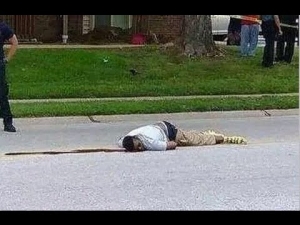 In The Lynching of Cleo Wright, Capeci draws from a wide range of archival sources and personal interviews with actual participants and spectators at this tragic event to draw vivid portraits of Wright, his victims, law-enforcement officials, and members of the lynch mob. Capeci places Wright in the larger context of southern racial violence and shows the significance of his death in local, state, and national history during the most important crisis of the twentieth century. It is ironic, and one could certainly argue the point that some 70 years after the lynching of Cleo Wright, a similar pattern is being played out some 150 miles north of Sikeston with the shooting death of unarmed black teenager Michael Brown by a white policeman, and just like with Wright, the Governor of Missouri and the Justice Department felt compelled to get involved.
In The Lynching of Cleo Wright, Capeci draws from a wide range of archival sources and personal interviews with actual participants and spectators at this tragic event to draw vivid portraits of Wright, his victims, law-enforcement officials, and members of the lynch mob. Capeci places Wright in the larger context of southern racial violence and shows the significance of his death in local, state, and national history during the most important crisis of the twentieth century. It is ironic, and one could certainly argue the point that some 70 years after the lynching of Cleo Wright, a similar pattern is being played out some 150 miles north of Sikeston with the shooting death of unarmed black teenager Michael Brown by a white policeman, and just like with Wright, the Governor of Missouri and the Justice Department felt compelled to get involved.
In his book the author chronicles a history of lynchings throughout the state of Missouri, including that of a Roosevelt Grigsby in nearby Charleston during the mid-1920s for allegedly attempting to rape a sixteen-year-old white girl.
The aforementioned Terry Teachout, in his Close to Home assessment of Capeci’s The Lynching of Cleo Wright in the Books section of The New York Times, May 30, 1999, had this to say: “It is a strange experience to learn about one’s hometown by reading a scholarly monograph, especially one written in a style that is two parts Joe Friday and one part academic lingo. Yet it was only by reading Capeci’s book that I learned of the myriad ways in which Wright’s ugly death overlapped with the idyllic small-town life of my boyhood. And though I spent countless hours talking with my best friend about everything under the sun, he never told me that his aunt was the woman Wright had knifed, or that it happened a half-dozen blocks from my childhood home, where my mother lives to this day.”
To put this story and area in the bootheel of Missouri in perspective, one need only to view YouTube video of Emory University Associate Professor of African American Studies, Carol Anderson, describing here. Also, to capture a sense of what Sikeston and Charleston was like around the time of the lynching of Cleo Wright, famed Hollywood director Roger Corman directed a movie in Charleston in 1962 called The Intruder, starring William Shatner of Star Trek fame. Parts of the movie was actually filmed at the high school in Charleston that I graduated from, and includes friends that I grew up with.
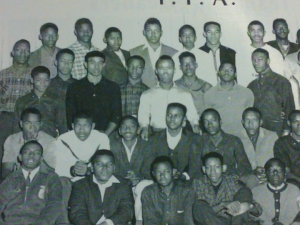 As I am depicted in this photo taken more than 50 years ago of Mr. Mullins' Lincoln School in Charleston Future Farmers of America (FFA) class along with my classmates, it is a resounding reminder of our affinity with Sikeston, but at this time not aware of the gruesome killing of Cleo Wright just 14 miles away. Sure, the aforementioned Marshall Currin was aware of it, but it was something that he chose not to share with us. Perhaps he wanted to spare us of the trauma of such an event at such a young and impressionable age. Very possibly everyone pictured here were served at Marshall Currin's (brother Marshall) restaurant in Charleston. It is ironic that after the aforementioned picture of me and my classmates were taken at Lincoln school in Charleston, the integration of Charleston High was brought about by the lawsuit here.
As I am depicted in this photo taken more than 50 years ago of Mr. Mullins' Lincoln School in Charleston Future Farmers of America (FFA) class along with my classmates, it is a resounding reminder of our affinity with Sikeston, but at this time not aware of the gruesome killing of Cleo Wright just 14 miles away. Sure, the aforementioned Marshall Currin was aware of it, but it was something that he chose not to share with us. Perhaps he wanted to spare us of the trauma of such an event at such a young and impressionable age. Very possibly everyone pictured here were served at Marshall Currin's (brother Marshall) restaurant in Charleston. It is ironic that after the aforementioned picture of me and my classmates were taken at Lincoln school in Charleston, the integration of Charleston High was brought about by the lawsuit here.
The movie was about the forced integration of the high school, and the racial strife that ensued. See YouTube movie. The aforementioned Marshall Currin makes a cameo appearance in this movie, standing in front of a church with a number of young people that I actually went to school and grew up with. There is a scene in this movie in which Klansmen blew up the church, killing the pastor. Corman would later say that he and his film crew would have to sneak out of Charleston under the cover of darkness, due to the filming of this movie, indicating fear for their wellbeing.
The iconic and soulful singer Billie Holiday puts this book and the subject of lynching in perspective with her song "Strange Fruit" here.
This is a fascinating book and story by Capeci, if for no other reason than to see if history repeats itself. It is also a disturbing story of man’s inhumanity to man.
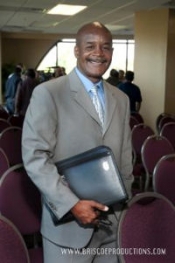 Dennis Moore is an Associate Editor for the East County Magazine in San Diego and the book review editor for SDWriteway, an online newsletter for writers in San Diego that has partnered with the East County Magazine. He is also the author of a book about Chicago politics; “The City That Works: Power, Politics and Corruption in Chicago.” He can be contacted at contractsagency@gmail.com or you can follow him on Twitter at: @DennisMoore8.
Dennis Moore is an Associate Editor for the East County Magazine in San Diego and the book review editor for SDWriteway, an online newsletter for writers in San Diego that has partnered with the East County Magazine. He is also the author of a book about Chicago politics; “The City That Works: Power, Politics and Corruption in Chicago.” He can be contacted at contractsagency@gmail.com or you can follow him on Twitter at: @DennisMoore8.







Comments
Dennis Moore Book Review, "The Lynching of Cleo Wright"
"Foreign media see U.S. hypocrisy in Ferguson"
Pages